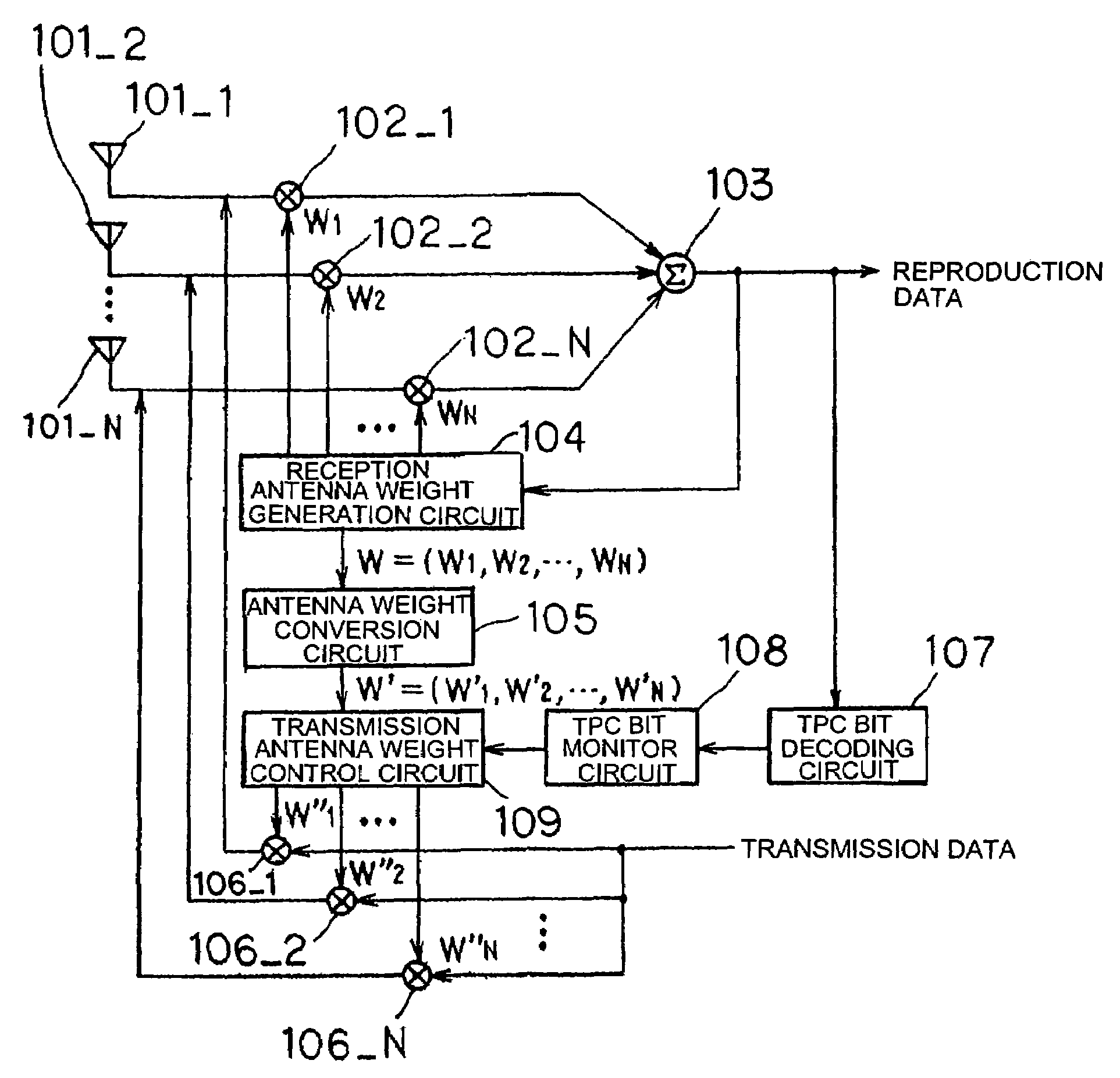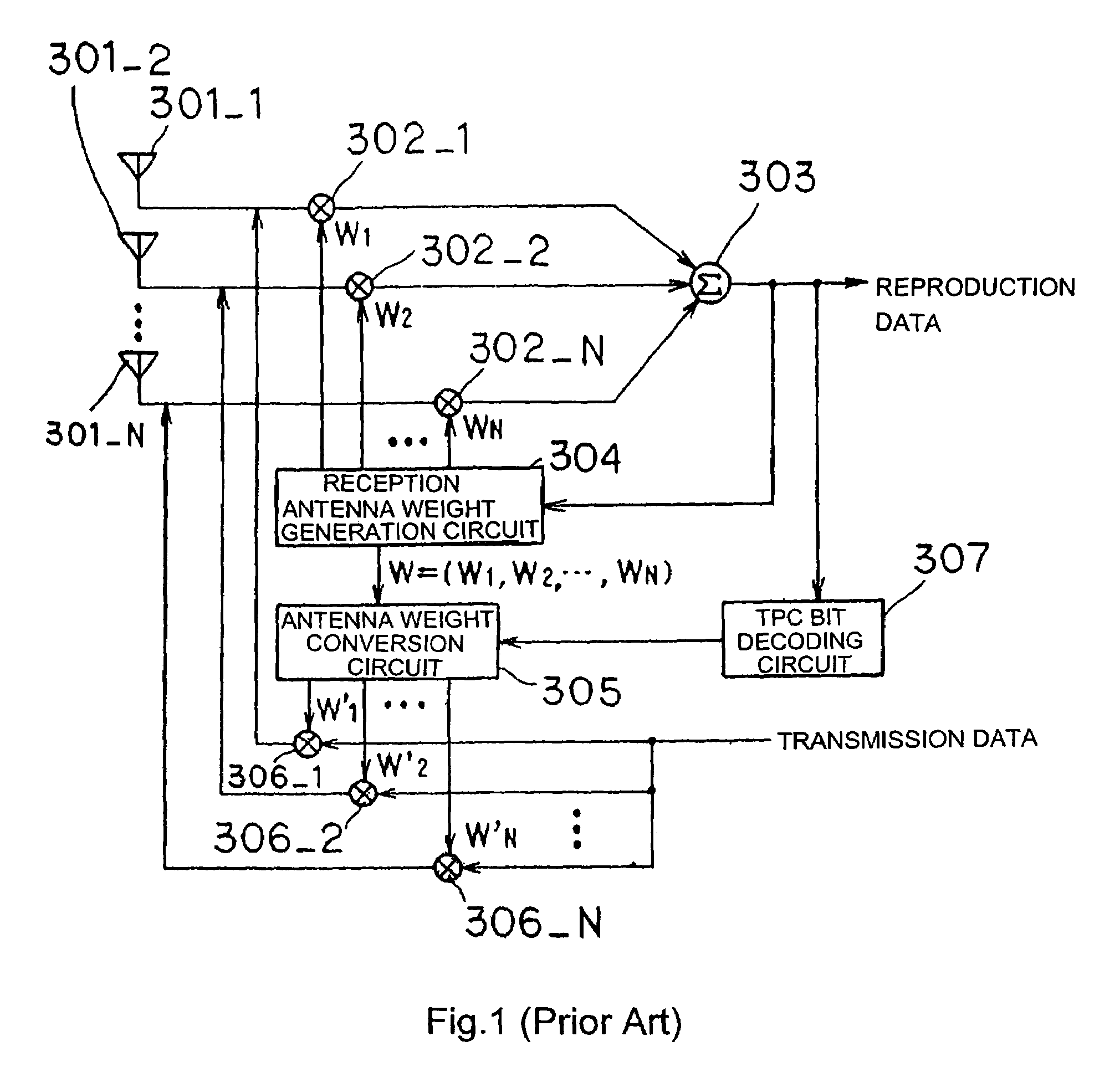Transmission beam control method, adaptive antenna transmitter/receiver apparatus and radio base station
a technology of transmission beam and receiver, applied in the field of transmission devices, can solve the problems of reducing the subscriber capacity that can be accommodated by limiting the subscriber capacity of the mobile communication system, etc., and achieve the effects of reducing the increase of transmission power, reducing interference power, and increasing the reception power of the mobile station
- Summary
- Abstract
- Description
- Claims
- Application Information
AI Technical Summary
Benefits of technology
Problems solved by technology
Method used
Image
Examples
first embodiment
[0029]As shown in FIG. 2, the transceiving device of the first embodiment includes: a plurality (N, where N is a positive integer) of antenna devices 101_1-101_N that are arranged in an array; receiving-side multipliers 102_1-102_N for multiplying reception antenna weights by received signals that have been received by antenna devices 101_1-101_N; adder 103 for adding (synthesizing) the plurality of received signals that have been multiplied by reception antenna weights and supplying the results as reproduction data; reception antenna weight generation circuit 104 for, based on the reproduction data that have been supplied as output from adder 103, calculating optimum reception antenna weights that are to be multiplied with received signals that have been received, and for supplying these optimum reception antenna weights to corresponding receiving-side multipliers 102_1-102_N; TPC bit decoding circuit 107 for extracting TPC bits from reproduction data and decoding instructions for ...
second embodiment
[0049]In the adaptive antenna transceiving device of the second embodiment, the transmission beam control procedure by transmission antenna weight control circuit 109 differs from that of the first embodiment. The configuration and operations are otherwise the same as the first embodiment, and redundant explanation is therefore omitted.
[0050]As shown in FIG. 6, in the adaptive antenna transceiving device of the second embodiment, a process is executed by transmission antenna weight control circuit 109 for alternately moving the peak direction of transmission beam 3 toward the left and right when the results of decoding the TPC bits in a prescribed interval show a bias toward instructions for increasing the transmission power. In the present embodiment, the peak direction is moved toward the right (or toward the left) by angle L that has been set in advance (“a” of FIG. 6) with respect to transmission beam 3 that is formed by first transmission antenna weights W′=(w′1, w′2, . . . , w...
third embodiment
[0057]In the adaptive antenna transceiving device of the third embodiment, the control procedure of the transmission beam by means of the transmission antenna weight control circuit differs from that of the first embodiment and the second embodiment. The configuration and operations are otherwise identical to the first embodiment, and redundant explanation is therefore omitted.
[0058]In the adaptive antenna transceiving device of the third embodiment, when the results of decoding the TPC bits are biased toward instructions for increasing the transmission power, the width of the main lobe is increased by a preset angle of ±H (where “+” is toward the right and “−” is toward the left) with respect to the transmission beam that is formed by the first transmission antenna weights W′=(w′1, w′2, . . . , w′N). If the conditions do not then improve (if the results of decoding the TPC bits are still biased toward instructions for increasing transmission power), the width of the main lobe of th...
PUM
 Login to View More
Login to View More Abstract
Description
Claims
Application Information
 Login to View More
Login to View More - R&D
- Intellectual Property
- Life Sciences
- Materials
- Tech Scout
- Unparalleled Data Quality
- Higher Quality Content
- 60% Fewer Hallucinations
Browse by: Latest US Patents, China's latest patents, Technical Efficacy Thesaurus, Application Domain, Technology Topic, Popular Technical Reports.
© 2025 PatSnap. All rights reserved.Legal|Privacy policy|Modern Slavery Act Transparency Statement|Sitemap|About US| Contact US: help@patsnap.com



